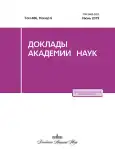Chronic exposure to ultrasonic frequencies results in selective increase of aggression level in rats
- Authors: Gorlova A.V.1, Pavlov D.P.1,2, Ushakova V.M.1, Zubkov E.A.3, Morozova A.Y.3, Zorkina Y.A.3, Inozemtsev A.N.1, Chekhonin V.P.3
-
Affiliations:
- Lomonosov Moscow State University
- Institute Of General Pathology And Pathophysiology
- Serbsky National Medical Research Centre of Psychiatry and Narcology under the RF Ministry of Public Health
- Issue: Vol 486, No 6 (2019)
- Pages: 753-755
- Section: Physiology
- URL: https://journals.eco-vector.com/0869-5652/article/view/14520
- DOI: https://doi.org/10.31857/S0869-56524866753-755
- ID: 14520
Cite item
Abstract
We studied aggression in male Sprague-Dawley rats in a model of a depressive-like state induced by unpredictable treatment with ultrasonic waves with the frequencies of 20-45 kHz for 1, 2 or 3 weeks. We did not find any increase in the number of animals exhibiting aggression in the “Resident- intruder” test after the treatment of any chosen duration. However, the aggressive animals exposed to ultrasound exhibited increased number of attacks and their total duration as well as decreased latency of the first attack compared to the respective scores in the animals of the control group. Taking this into account, we suggest that the initial level of aggression increases in a model of ultrasonic chronic stress.
Keywords
About the authors
A. V. Gorlova
Lomonosov Moscow State University
Author for correspondence.
Email: anna.gorlova204@gmail.com
Russian Federation, 1, Leninskie gory, Moscow, 119991
D. P. Pavlov
Lomonosov Moscow State University; Institute Of General Pathology And Pathophysiology
Email: anna.gorlova204@gmail.com
Russian Federation, 1, Leninskie gory, Moscow, 119991; 8, Baltiyskaya st., Moscow, 125315
V. M. Ushakova
Lomonosov Moscow State University
Email: anna.gorlova204@gmail.com
Russian Federation, 1, Leninskie gory, Moscow, 119991
E. A. Zubkov
Serbsky National Medical Research Centre of Psychiatry and Narcology under the RF Ministry of Public Health
Email: anna.gorlova204@gmail.com
Russian Federation, 23, Kropotkin lane, Moscow, 119034
A. Y. Morozova
Serbsky National Medical Research Centre of Psychiatry and Narcology under the RF Ministry of Public Health
Email: anna.gorlova204@gmail.com
Russian Federation, 23, Kropotkin lane, Moscow, 119034
Y. A. Zorkina
Serbsky National Medical Research Centre of Psychiatry and Narcology under the RF Ministry of Public Health
Email: anna.gorlova204@gmail.com
Russian Federation, 23, Kropotkin lane, Moscow, 119034
A. N. Inozemtsev
Lomonosov Moscow State University
Email: anna.gorlova204@gmail.com
Russian Federation, 1, Leninskie gory, Moscow, 119991
V. P. Chekhonin
Serbsky National Medical Research Centre of Psychiatry and Narcology under the RF Ministry of Public Health
Email: anna.gorlova204@gmail.com
Academician of the Russian Academy of Sciences Russian Federation, 23, Kropotkin lane, Moscow, 119034
References
- Pehrson A.L., Sanchez C. Altered -Aminobutyric Acid Neurotransmission in Major Depressive Disorder: a Critical Review of the Supporting Evidence and the Influence of Serotonergic Antidepressants // Drug. Des. Devel. Ther. 2015. V. 19. № 9. P. 603-624.
- Morozova A., Zubkov E., Strekalova T., Kekelidze Z., Storozeva Z., Schroeter C.A., Lesch K.P., Cline B.H., Chekhonin V. Ultrasound of Alternating Frequencies and Variable Emotional Impact Evokes Depressive Syndrome in Mice and Rats // Prog. Neuro¬psycho¬pharmacol. Biol. Psychiatry. 2016. V. 68. P. 52-63.
- Горлова А.В., Павлов Д.А. , Ушакова В.М., Зубков Е.А., Морозова А.Ю., Иноземцев А.Н., Чехонин В.П. Динамика развития депрессивно-подобного состояния у крыс, стрессированных хроническим воздействием ультразвука переменных частот // Бюл. экс¬перим. биологии и медицины. 2017. Т. 163. № 3. С. 271-274.
- Brudzynski S.M. Ultrasonic Calls of Rats as Indicator Variables of Negative or Positive States: Acetyl¬cho¬line¬dopamine Interaction and Acoustic Coding. // Behav. Brain Res. 2007. V. 182. № 2. P. 261-73.
- Litvin Y., Blanchard D.C., Blanchard R.J. Rat 22 kHz Ultrasonic Vocalizations as Alarm Cries. // Behav. Brain Res. 2007. V. 182. № 2. P. 166-172.
- Морозова А.Ю., Зубков Е.А., Сторожева З.И., Кекелидзе З.И., Чехонин В.П. Влияние излучения ультразвукового диапазона на формирование симптомов депрессии и тревожности у крыс. // Бюл. экс¬перим. биологии и медицины. 2012. Т. 154. № 12. C. 705-708.
- Смулевич А.Б. Депрессии и коморбидные расстройства. М., 1997. 155 с.
- Meyrueix L., Durham G., Miller J., Smalley K.M., Warren J.C. Association between Depression and Aggression in Rural Women. // J Health Dispar Res Pract. 2015. V. 8. № 4. P. 136-144.
- Pikó B., Pinczés T. Impulsivity - Aggression - Depression: Study of Adolescents’ Problem Behavior in Light of Their Personality Traits // Psychiatr. Hung. 2014. V. 29. № 1. P. 48-55.
- Koolhaas J., Coppens C., de Boer S., Buwalda B., Meerlo P., Timmermans P. The Resident-Intruder Paradigm: A Standardized Test for Aggression, Violence and Social Stress // J. Vis. Exp. 2013. V. 77. № 4. Р. 4367.
- Горлова А.В., Павлов Д.А., Зубков Е.А., Морозова А.Ю., Иноземцев А.Н., Чехонин В.П. Трехнедельная изоляция не приводит к развитию депрессивно-подобных нарушений у крыс // Бюл. эксперим. биологии и медицины. 2018. Т. 165. № 2. С. 140-143.
- Павлов Д.А., Горлова А.В., Ушакова В.М., Зубков Е.А., Морозова А.Ю., Иноземцев А.Н., Чехонин В.П. Влияние хронического действия ультразвука переменных частот на уровни агрессии и тревожности у мышей линий CBA и BALB/c. // Бюл. эксперим. биологии и медицины. 2017. Т. 163. № 4. С. 400-403.
- Llorca A., Malonda E., Samper P. The Role of Emotions in Depression and Aggression // Med. Oral. Patol. Oral. Cir. Bucal. 2016. V. 21. No. 5. P. 559-564.
Supplementary files








